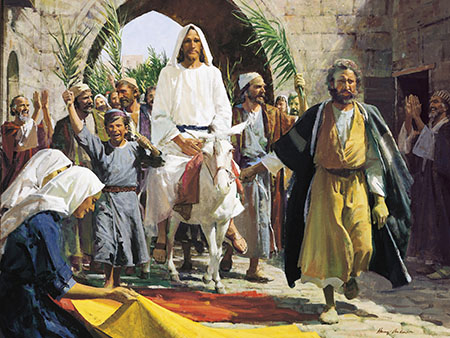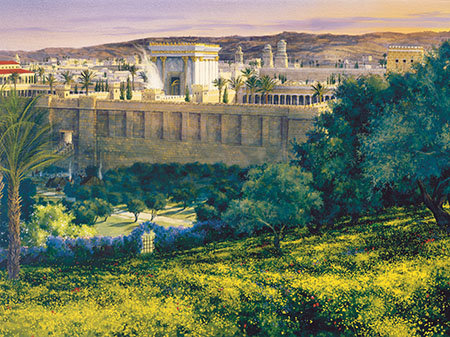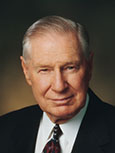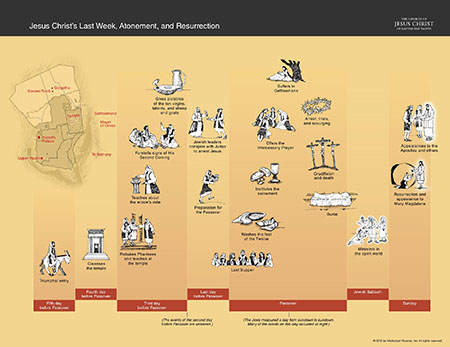Lesson 23: Matthew 21:1–16
Introduction
Jesus made His triumphal entry into Jerusalem at the beginning of the last week of His life. While there, He cleansed the temple for the second time and healed the blind and the lame who came to Him.
Suggestions for Teaching
Note: At the end of this lesson is a one-page visual titled “Jesus Christ’s Last Week, Atonement, andResurrection.” This brief overview of the last week of the Savior’s mortal life can help you and your students understand the events that led up to Jesus Christ’s death and Resurrection. You may want to use this overview in Mark, Luke, and John as well.
Matthew 21:1–11
Jesus Christ makes His triumphal entry into Jerusalem
Display an item of food or write the name of a food on the board. Ask students to indicate whether they have tasted this food and would recommend it to others. Invite a student who would recommend the food to come to the front of the class. Ask him or her to imagine that no one else has tasted this food. Instruct the student to demonstrate what he or she would say or do to help someone develop a desire to try this food. Invite the student to return to his or her seat when finished. Then ask the class:
- • If you had not tasted this food before, how likely would you be to want to try it now? Why?

Display a picture of the Savior. Explain that many people have little knowledge of Jesus Christ and His gospel and that we have the responsibility to help others learn about Him.
Ask students to ponder what they could do to help someone want to know more about Jesus Christ. Invite them to look for a principle as they study Matthew 21:1–11 that can help them as they encourage others to learn more about Jesus Christ.
Explain that Matthew 21 records the events that took place five days before the Savior’s Crucifixion. Remind students that a multitude of people followed Jesus and His Apostles as they traveled to Jerusalem from Jericho (see Matthew 20:17–18, 29).
Invite a student to read Matthew 21:1–5 aloud. Ask the class to follow along, looking for what Jesus instructed two of His disciples to do.
- • What did Jesus instruct these disciples to do?
Explain that the prophecy referenced in Matthew 21:4–5 is found in Zechariah 9:9–10. (Invite students to consider writing this reference next to verse 5.) This prophecy was about the promised Messiah, or “the anointed Prophet, Priest, King, and Deliverer whose coming the Jews were eagerly expecting” (Guide to the Scriptures, “Messiah,” scriptures.lds.org). Point out that in biblical times, the donkey “was a symbol of Jewish royalty. … Riding on a donkey … showed that Jesus came as a peaceful and ‘lowly’ Savior, not as a conqueror upon a warhorse” (New Testament Student Manual [Church Educational System manual, 2014], 64).
- • What are some actions in different cultures that show respectful acknowledgment of royalty?
Invite a student to read Matthew 21:6–8 aloud. Ask the class to follow along, looking for what “a very great multitude” (verse 8) did as Jesus rode into Jerusalem. (You may want to point out to students that Joseph Smith Translation, Matthew 21:5 [in Matthew 21:7, footnote a], clarifies that only one animal was brought and ridden.)
- • What did the multitude do to respectfully acknowledge Jesus as the Messiah? (You might point out that the Gospel of John specifies that the multitude used “branches of palm trees” [John 12:13]. Palm branches were a Jewish symbol of victory and triumph over enemies. Providing a carpeted path, like the one the multitude created using branches and clothing, was a gesture used to honor royalty or conquerors. By doing this, the multitude acknowledged and welcomed Jesus as their Deliverer and King.)

Display the picture Triumphal Entry (Gospel Art Book[2009], no. 50; see also LDS.org). Ask students to imagine that they are one of the people in this picture. Read the first part of Matthew 21:9 aloud, and invite the class to read aloud in unison the multitude’s cry in the second half of the verse as if they were part of the multitude.
- • What word did the people repeat? (Hosanna.)
Explain that hosanna means “save now” (BibleDictionary, “Hosanna”). Ask students to consider writing this definition in their scriptures next to verse 9.
Explain that part of the multitude’s cry fulfilled the messianic prophecy found inPsalm 118:25–26. You may want to suggest that students write this reference next toMatthew 21:9. Explain that the royal and messianic title “Son of David” (verse 9) was reserved for the heir to the throne of David.
- • By making this cry, who were the people declaring Jesus was?
- • If you had been living in Jerusalem at this time, what thoughts or feelings might you have had as you witnessed the Savior’s triumphal entry?
Point out that thousands of additional people were in Jerusalem at that time to celebrate the Passover. Invite a student to read Matthew 21:10–11 aloud. Ask the class to follow along, looking for the effect of the multitude’s behavior on others in Jerusalem.
- • What question did others ask because of the multitude’s behavior?
- • As illustrated in this account, what can happen as we publicly acknowledge and speak about Jesus Christ? (Students may use different words but should identify the following principle: As we publicly acknowledge and speak about Jesus Christ, we can help others develop a desire to know more about Him. You might want to write this principle on the board.)
- • What are some settings outside of Church meetings where we can publicly acknowledge and speak about Jesus Christ? (Help students understand that, when appropriate, we can do this in formal settings, through social media, and during conversations with friends, family members, and neighbors.)
- • How can we publicly acknowledge and speak about Jesus Christ in a way that will help others want to know more about Him?
- • How would you answer if you were asked who Jesus Christ is?
Write the following questions on the board, and invite students to respond to one of them in their class notebooks or scripture study journals:
When have another person’s efforts to publicly acknowledge and speak about Jesus Christ led you to want to know more about Him?
When have you (or someone you know) helped someone want to know more about Jesus Christ because you publicly acknowledged and spoke about Him?
After sufficient time, invite several students who are willing to share what they wrote.
Encourage students to look for and take opportunities to appropriately acknowledge and speak about Jesus Christ.
Matthew 21:12–16
Jesus cleanses the temple and heals the blind and the lame
Display a picture of a Latter-day Saint temple located close to where you live. Invite students to ponder and describe the thoughts and feelings they had the last time they visited the temple. If students have never been to the temple, ask them to describe how they think they would feel inside the temple.
- • What happens in the temple that enables us to experience these feelings?

Display the picture My Father’s House (Gospel Art Book[2009], no. 52; see also LDS.org). Explain that after the Savior entered Jerusalem, He went to a courtyard on the temple grounds. Invite a student to read Matthew 21:12–13 aloud. Ask the class to follow along, looking for what some people were doing that was offensive to Heavenly Father and Jesus Christ.
- • How were some people treating God’s house?
Explain that the visitors who came to Jerusalem to celebrate the Passover needed to purchase animals to offer as sacrifices in the temple as part of their worship. Moneychangers exchanged Roman and other currencies for temple currency so the animals could be purchased, and other merchants sold the animals.
- • What was wrong about conducting this type of business on the grounds of the temple?
You may want to point out that even though this business was necessary and served a good purpose, handling it where and how the merchants did was disrespectful and irreverent. Verse 13 suggests that the moneychangers and merchants were more interested in making a financial profit than in worshipping God and helping others to do so.
- • What truth about the temple can we learn from the Savior’s words and actions? (Students may use different words, but make sure they identify the following truth: The house of the Lord is a sacred place, and He desires that we treat it with reverence.)
- • How can we show reverence for the house of the Lord?
- • How can worthily attending the temple show reverence for it?
Invite a student to read Matthew 21:14 aloud. Ask the class to follow along, looking for what the Savior did in the temple after cleansing it.
- • What did the Savior do for the blind and the lame who came to Him in the temple?
- • What can we learn from this account about what the Lord can do for us as we attend the temple? (Make sure students identify the following truth: As we attend the temple, the Lord can heal us.)
- • In addition to physical ailments, what other illnesses and challenges can the Lord heal as we attend the temple?
Invite a student to read aloud the following statement by President James E. Faust of the First Presidency. Ask students to listen for President Faust’s testimony of the truth they identified.

“The Lord has provided many avenues by which we may receive [His] healing influence. I am grateful that the Lord has restored temple work to the earth. It is an important part of the work of salvation for both the living and the dead. Our temples provide a sanctuary where we may go to lay aside many of the anxieties of the world. Our temples are places of peace and tranquillity. In these hallowed sanctuaries God ‘healeth the broken in heart, and bindeth up their wounds.’ (Ps. 147:3.)” (“Spiritual Healing,” Ensign, May 1992, 7).
- • Why does worshipping in the Lord’s house help us experience His healing influence?
Explain that the healing we experience as we worship in the temple can be immediate, as it was for the blind and the lame described in this account, or it can take place over time.
- • When have you, or someone you know, experienced the Lord’s healing influence by worshipping in the temple? (You may also want to share an experience of your own.)
Summarize Matthew 21:15–16 by explaining that the chief priests and scribes were displeased with what Jesus did in the temple and with the people crying “Hosanna” to Him there. Jesus pointed out that the people’s public acknowledgment of Him fulfilled a prophecy (see Psalm 8:2).
Conclude by sharing your testimony of the truths discussed in this lesson.
Commentary and Background Information
Matthew 21:8. Spreading palm branches and garments before Jesus
Elder Bruce R. McConkie of the Quorum of the Twelve Apostles taught what it meant for the people to spread palm branches (see John 12:13) and their garments before Jesus as He entered into Jerusalem:
“Only kings and conquerors received such an extraordinary token of respect as this. (2 Kings 9:13.) … Amid shouts of praise and pleas for salvation and deliverance, we see the disciples strewing our Lord’s course with palm branches in token of victory and triumph. This whole dramatic scene prefigures that yet future assembly when ‘a great multitude,’ which no man can number, … shall stand ‘before the throne, and before the Lamb, clothed with white robes, and palms in their hands,’ crying with a loud voice, ‘Salvation to our God which sitteth upon the throne, and unto the Lamb.’ (Rev. 7:9–10.)” (Doctrinal New Testament Commentary, 3 vols. [1965–73], 1:578).
Matthew 21:9–11. The multitude cried, “Hosanna”
“Hosanna is a Hebrew word that ‘means “please save us” and is used in praise and supplication. … At the Lord’s triumphal entry into Jerusalem, the multitudes cried “Hosanna” and spread palm branches for Jesus to ride upon, thus demonstrating their understanding that Jesus was the same Lord who had delivered Israel anciently (Ps. 118:25–26; Matt. 21:9, 15; Mark 11:9–10;John 12:13). These people recognized Christ as the long-awaited Messiah’ (Guide to the Scriptures, “Hosanna”; scriptures.lds.org). The phrase ‘all the city was moved’ (Matthew 21:10) suggests that Jesus’s triumphal entry was noised throughout the city and was known by many people” (New Testament Student Manual[Church Educational System manual, 2014], 64–65).
Supplemental Teaching Idea
Matthew 21:7–11. Speaking about Jesus Christ to others
The following instruction can help students further understand the truth that as we publicly acknowledge and speak about Jesus Christ, we can help others develop a desire to know more about Him.
After asking students to name settings where we can publicly acknowledge and speak about Jesus Christ, invite a student to read aloud the following statement by Elder David A. Bednar of the Quorum of the Twelve Apostles. Ask the class to listen for one setting where we can publicly speak about Jesus Christ and other gospel truths.
“Social media channels are global tools that can personally and positively impact large numbers of individuals and families. And I believe the time has come for us as disciples of Christ to use these inspired tools appropriately and more effectively to testify of God the Eternal Father, His plan of happiness for His children, and His Son, Jesus Christ, as the Savior of the world; to proclaim the reality of the Restoration of the gospel in the latter days; and to accomplish the Lord’s work” (“To Sweep the Earth as with a Flood” [address given at BYU Campus Education Week, Aug. 19, 2014], LDS.org).
- • How can we use social media to help others want to know more about Jesus Christ?
- • What did the young woman do to share the gospel of Jesus Christ?


沒有留言:
張貼留言